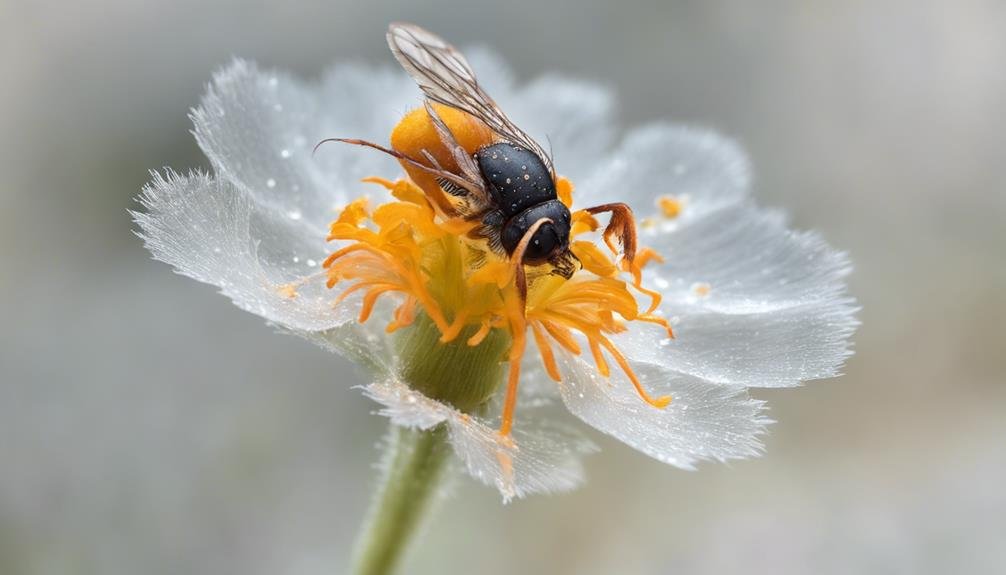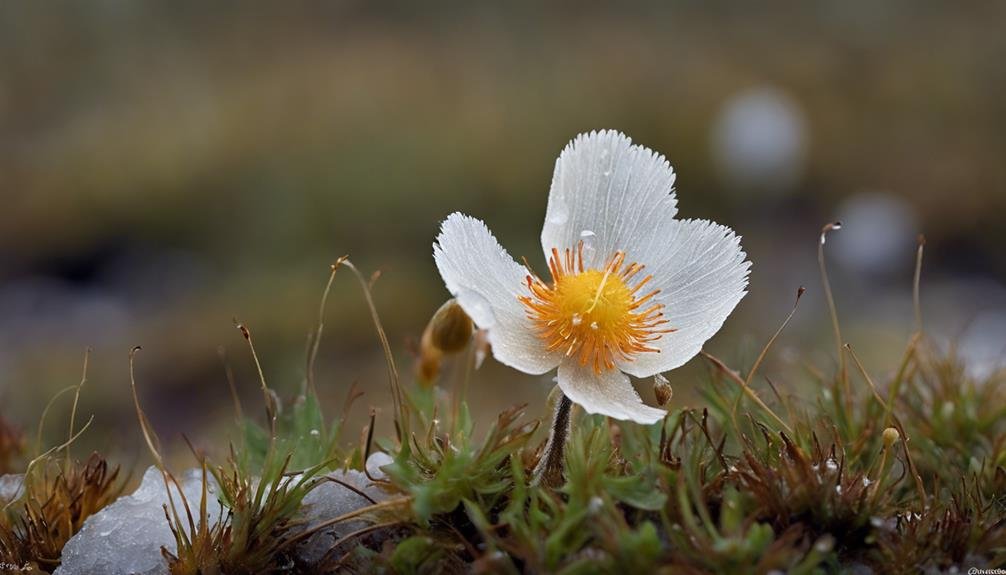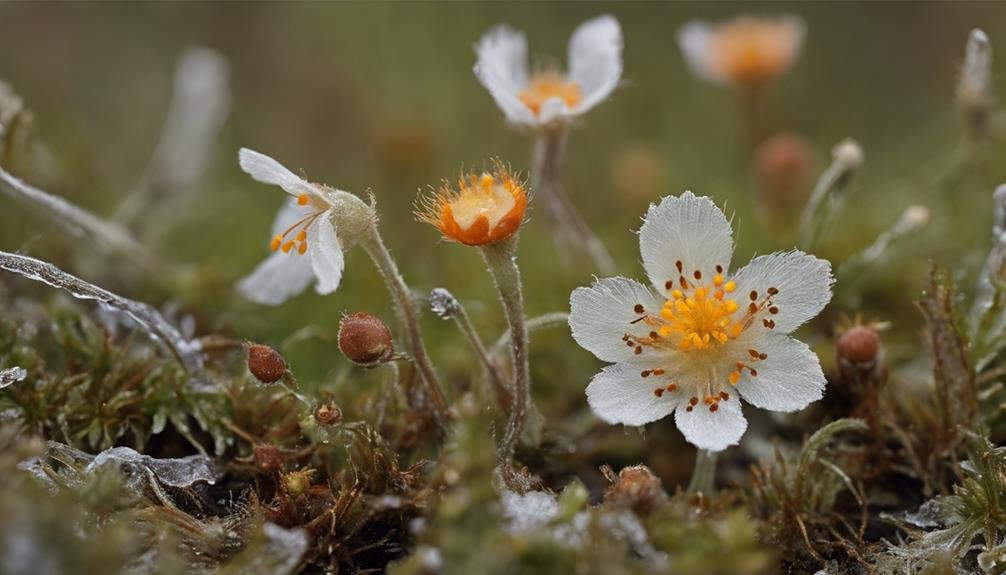Why do some plants thrive in the harsh conditions of alpine environments while others struggle? The answer lies in the remarkable adaptability and resilience of species like the Mountain Avens (Dryas octopetala). This perennial plant not only survives but flourishes in cold climates, becoming a symbol of nature’s tenacity.
Mountain Avens has developed several fascinating adaptations that allow it to prosper in its challenging habitat. One of its most notable features is heliotropism, the ability to move in response to the sun. This movement ensures that the plant can maximize its exposure to sunlight, crucial for photosynthesis, especially in environments where warmth and light are limited. Moreover, the plant has a unique seed dispersal mechanism. Its seeds are attached to silky feathers, which can be carried far and wide by the wind, allowing Dryas octopetala to colonize large areas of the tundra efficiently.
Despite its adaptability, Mountain Avens is not invulnerable. Certain populations face threats that could impact their survival, pointing to the complex interplay of factors that govern the existence of alpine flora. These vulnerabilities underscore the need for ongoing research and conservation efforts to ensure the longevity of Dryas octopetala and its role in the ecosystem. Understanding the ecological significance and the conservation needs of Mountain Avens is essential for preserving the biodiversity of alpine and tundra ecosystems.
Key Takeaways
To encapsulate, the Mountain Avens (Dryas octopetala) displays a remarkable adaptation to sunlight, enhancing pollination success. Its eight-petaled flowers contribute to the biodiversity of Arctic tundra ecosystems, reflecting its evolutionary adaptations to harsh conditions.
Observations indicate areas of vulnerability for Mountain Avens, highlighting the necessity for ongoing conservation efforts. The species’ ecological importance and adaptability are key scientific interests, encouraging further study to understand its impact in alpine and arctic settings.
Key Takeaways:
- The Mountain Avens exhibits unique sunlight adaptation, aiding in pollination.
- Its eight-petaled flowers boost Arctic tundra biodiversity, illustrating evolutionary resilience.
- Noted vulnerabilities stress the need for conservation to safeguard Mountain Avens.
- The plant’s ecological role in alpine and arctic regions warrants additional research.
Arctic-Alpine Flower Overview
Mountain Avens: A Keystone of Arctic-Alpine Ecosystems
The Mountain Avens (Dryas octopetala), though modest in its demeanor, holds a pivotal position within the ecosystems of the arctic tundra. Originating in the northern expanses of Eurasia and North America, this species has ingeniously adapted to flourish in the challenging conditions it encounters. It spreads its roots beyond its native lands, reaching into the alpine realms of the Cascades and Rocky Mountains, where it ascends above the forest canopy.
Heliotropism: A Dance with the Sun
One of the most captivating aspects of Dryas octopetala is its heliotropic flowers. These creamy-white blooms perform a daily ritual, tracking the sun across the sky. This not only maximizes the exposure of the pistils to sunlight but also plays a vital role in the pollination process, especially crucial in the cooler climates where it resides. This adaptation ensures that despite the frigid temperatures, pollination proceeds effectively, securing the plant’s reproduction and survival.
Seed Dispersal: Riding the Wind
Equally remarkable is the plant’s method of seed dispersal. Dryas octopetala produces achenes, each equipped with silky, feather-like hairs. These hairs catch the wind, carrying the seeds across great distances. This strategy not only facilitates the widespread distribution of the species but also promotes genetic diversity, a key factor in the resilience and adaptability of the species across its extensive range.
Cultivation and Care: Thriving in Diversity
Adaptable and resilient, the Mountain Avens is an ideal choice for rock gardens, walls, or borders. It prospers in environments that offer full sun to light shade and requires well-drained soils. This versatility underscores the plant’s ability to thrive in a range of arctic-alpine habitats, making it a valued addition to gardens aiming to mimic these conditions.
Eight-Petaled Blossoms

Dryas octopetala: A Marvel of Evolution
The eight-petaled flowers of Dryas octopetala serve as a testament to the plant’s remarkable adaptation to its environment. These creamy-white petals aren’t just visually appealing but play a crucial role in the plant’s survival and reproduction in the harsh conditions of arctic and alpine regions.
Sun Following Blossoms
One fascinating aspect of these flowers is their heliotropic behavior. This means they’ve the ability to follow the sun across the sky. This movement isn’t just a whimsical dance; it’s a strategic adaptation. By tracking the sunlight, the blossoms ensure they’re always in the optimal position for photosynthesis. This is especially important in their nutrient-poor environments, where making the most of the available sunlight is key to the plant’s energy acquisition.
Woolly Seeds for the Future
After the flowers are pollinated, they undergo a transformation to secure the next generation. Each flower gives rise to a woolly cluster of single-seeded achenes. This fluffy structure isn’t just for show; it plays a pivotal role in seed dispersal. The woolly covering catches the wind, allowing the seeds to travel far from the parent plant. This dispersal mechanism is vital for the propagation of the species and ensures the continuation of its genetic lineage across the rugged landscapes it calls home.
Alpine Beauty in Gardens
Beyond its survival mechanisms, the eight-petaled structure of Mountain Avens holds significant appeal for gardeners and landscape designers. Its unique appearance and resilience make it a desirable choice for those looking to add a touch of the wild, rugged beauty of alpine and arctic settings to their gardens. The plant’s ornamental value, combined with its adaptability, makes it a standout addition to any garden aiming to replicate the enchanting visuals of its natural habitat.
Global Arctic Tundra Presence

Adaptations and Distribution of Dryas Octopetala Across the Arctic Tundra
Delving into the world of Dryas octopetala, we uncover its remarkable ability to flourish in the extreme conditions of the Arctic tundra. This species isn’t just surviving but thriving across vast regions of northern Eurasia and North America, a testament to its adaptability and resilience. The variations in growth forms, from those suited to late snowbed sites to others thriving on rocky scree slopes, highlight Dryas octopetala‘s genetic versatility. This adaptability isn’t merely a biological curiosity but a critical survival strategy in the unpredictable Arctic environments.
Dryas Octopetala: A Window into Past Climates
The distribution of Dryas octopetala offers more than a snapshot of current ecological success; it provides a portal into our planet’s climatic past. Fossils associated with the Older and Younger Dryas periods serve as tangible links to times of significant climate upheaval. These botanical remnants are invaluable for reconstructing the history of arctic-alpine vegetation and extending our understanding of tundra expanses through time. Dryas octopetala stands as a bioindicator, its presence during these pivotal periods offering insights into historical climate dynamics.
Significance in Biogeographical and Paleoclimatic Research
The widespread occurrence of Dryas octopetala in the Arctic tundra underscores its importance in both biogeographical and paleoclimatic contexts. Its ability to adapt to various Arctic conditions not only speaks to its ecological role but also enhances our ability to interpret past climates. Through the lens of Dryas octopetala, researchers can better understand the complex interplay between climate, vegetation, and the evolving landscape of the global Arctic tundra. This plant, resilient and enduring, serves as a key piece in the puzzle of our planet’s environmental history.
Pollination Strategy

Delving into the Pollination Dynamics of Dryas octopetala
The intricate dance of pollination within the Arctic tundra showcases the delicate relationship between Mountain Avens and their insect collaborators. The vibrant, creamy blossoms of Dryas octopetala serve more than an aesthetic purpose; they’re vital players in the web of arctic survival, enticing pollinators through their allure.
Vital Role of Insect Pollinators
The bustling activity of bees and flies around the flowers of Dryas octopetala is no mere coincidence. These insects are the linchpins in the pollination mechanism of the plant, facilitating the crucial transfer of pollen. This symbiotic relationship kickstarts the reproduction process, ensuring the continuation of the species.
The Essence of Genetic Diversity
Through the act of cross-pollination, a tapestry of genetic variation is woven, fortifying Mountain Avens against the harsh realities of their environment. This genetic resilience is key to their survival, enabling them to adapt to changing conditions and resist diseases.
Mechanisms of Seed Dispersal
Once pollination has been successfully achieved, the formation of achenes marks the beginning of a new chapter in seed dispersal. This stage is critical for the spread of Dryas octopetala, allowing for the rejuvenation and expansion of populations across the expansive arctic tundra.
In the grand scheme of arctic biodiversity, pollinators emerge as unsung heroes, ensuring the genetic diversity and continuity of Dryas octopetala amidst the challenges of their frigid habitat.
Vulnerable in Specific Regions

Challenges Facing Mountain Avens in Arctic Regions
Environmental Threats to Mountain Avens
The arctic tundra is a resilient ecosystem, yet it’s home to species like the Mountain Avens that now find themselves under threat. The primary concern for these plants stems from habitat destruction, a direct result of human activities. Mining operations and unsound land management practices are particularly damaging, leading to the degradation of the limestone habitats critical for the survival of Mountain Avens.
Climate Change Impact
Changes in temperature and precipitation patterns due to climate change are disrupting the arctic and sub-arctic ecosystems. Such disruptions pose a severe threat to Mountain Avens, making these plants more vulnerable to disease and less competitive against other species. The delicate balance of their ecosystem is at risk, highlighting the need for targeted conservation efforts.
Conservation Measures for Mountain Avens
To protect Mountain Avens, it’s vital to focus on preserving and restoring their unique limestone habitats. Efforts must also address the broader issue of climate change to ensure the long-term survival of this species in its specific regions. Conservation strategies are key to safeguarding the future of Mountain Avens in vulnerable mountainous areas across northern Eurasia and North America.
Frequently Asked Questions
What Is the Meaning of Dryas Octopetala?
Q: What is Dryas octopetala?
A: *Dryas octopetala* is a plant species known for its white, star-shaped flowers and its ability to flourish in alpine and arctic environments. This plant is notable for its ecological role and the distinctive eight-petaled flowers from which its name is derived.
What Is the Difference Between Dryas Integrifolia and Octopetala?
What are the main differences between Dryas integrifolia and Dryas octopetala?
Question: How do Dryas integrifolia and Dryas octopetala differ in physical and ecological characteristics?
Answer: Dryas integrifolia and Dryas octopetala are distinguished by their leaf shapes, habitat preferences, and geographic distributions. Dryas integrifolia has entire leaves, meaning they are smooth-edged, while Dryas octopetala features leaves with distinct lobes. They also differ in their flower structures, pollination strategies, and seed dispersal methods, which are adaptations to their specific environments.
How Tall Do Mountain Avens Get?
How Tall Can Mountain Avens Grow?
Mountain Avens typically reach a height of 2-8 inches. They thrive in well-drained soil and prefer conditions ranging from full sun to light shade. This plant is known for its adaptability to various climates and its long flowering period, making it an ideal groundcover that attracts a wide range of wildlife.
What Kind of Plant Is Dryas?
What Type of Environment Does the Dryas Plant Prefer?
Dryas is a plant that thrives in Arctic habitats. Its adaptability to cold climates and specific soil types makes it a resilient species in its native ecosystem.
How Does Dryas Pollinate?
Dryas utilizes effective pollination methods that allow it to reproduce successfully in its Arctic environment, ensuring its survival and proliferation.
What Is the Conservation Status of Dryas?
The conservation status of Dryas reflects its ability to adapt to its environment, indicating its resilience and the important ecological role it plays in its habitat.
Conclusion
To sum up, the Mountain Avens (Dryas octopetala) showcases a fascinating adaptation through its response to sunlight, which greatly improves its chances of pollination. The presence of its distinctive eight-petaled flowers not only enriches the biodiversity within the Arctic tundra ecosystems but also serves as a testament to its evolutionary adjustments to extreme conditions.
However, vulnerability in certain areas has been noted, underscoring the imperative for continued conservation efforts to protect this species. The ecological significance and adaptability of Mountain Avens are of great interest scientifically, prompting further research to fully comprehend its role and contributions to both alpine and arctic environments.





0 Comments